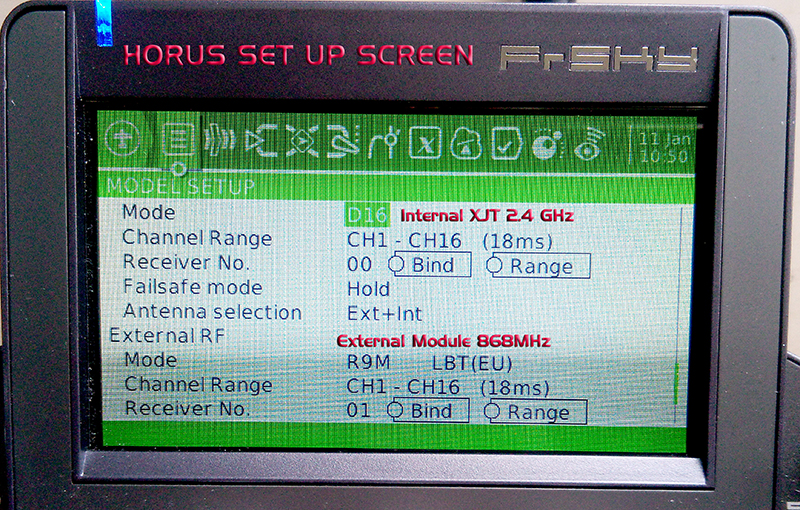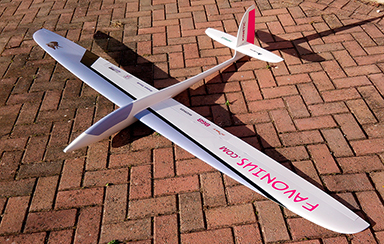|
What do these numbers have in common?
27, 35, 459, 868, 2400
No, this isn’t part of an IQ test;
these are R/C aircraft bands we can use legally in the UK, so yes, I want to
write a little bit about R/C radio, RF modules and dual-band operation. My first
radio was a simple Horizon two
channel set on 27MHz and I’m talking decades ago. It was made in Kempston,
Beds, I believe. It was a set that had multiple problems and went back a few
times. Radio was expensive in those days and a two channel set was all I could
afford. After those early radio problems I had a series of other 27 and 35MHz
sets: Macgregor, Skyleader, Robbe, Futaba
and Multiplex and recently a modern
FrSky or two. I had bought a module
for the 35MHz Multiplex 3030 set and this gave me my first good experiences on
2.4GHz. Modules are what I am writing about in this piece. I don’t
think any of us oldies have looked back since the introduction of 2.4GHz; no
more shoot downs, pegboards and peg-waiting in order to fly. Trouble is, while
2.4 is great, it is not perfect. There are a couple of reasons for this, it is pretty
much line of sight and does not like going through or round obstacles in its
path. Anyone with a telemetry set will tell you that someone simply walking in
front of you can reduce the received signal; let alone a drop below the level
of the hill top or behind the little hump on the Beacon’s top.
The second reason is carbon fibre,
especially in fuselages. Last year I put my Aresti 2M in on the front of the
slope; I attributed the crash to the all-carbon nature of the model and a
failsafe. High frequency radio waves do not penetrate carbon very well, since
it can act like a Faraday Cage around
a receiver, hence the so called ‘2.4
safe’ fuselages. These are fuzzes where the nose of a model is deliberately
left void of carbon to ‘allow’ radio waves to reach the receiver. Carbon fibre
flying surfaces can also blank incoming signals and cause problems/failsafes. Signal Strength Even if you have a radio that gives
you RSSI this is not necessarily a fair indicator of control (i.e. it is not an empirical measure of dBm). RSSI on model sets is generally
just a number from 0-100, the higher number you receive the better… well, yes
and no. Generally anything above 50 is good, FrSky defaults are 45 and 42 and
remember this is a logarithmic scale. If the noise floor is high then the RSSI may
appear high as well but not necessarily
because of your transmitter signal. That RSSI value is could be telling you the strength of all signals resonating in your
receiver antenna including background stuff on the same band. While this is not
a problem for us in the open countryside flying, in a built up area surrounded
by houses like Hockcliffe, I imagine, and all that Wifi can be dodgy.
Everything these days seems to use 2.4GHz. My Wifi uses
it as does my printer; I have a radio doorbell and an electric garage door
opener. I know my brother has three Wifi routers going at the same time; then
there’s all that Bluetooth in the ćther as well. Just switch on your computer
and see all your neighbours’ Wifi signals. This is the background noise that
your tiny receiver has to sift through to get its personal instructions.
Just one hop
865.295MHz in 863-869 ISM band, note the noise floor.
So a rhetorical ‘why change from 2.4GHz’. The simple
answer is that you don’t have to change if you’re flying close by, just a couple
of hundred metres away in the countryside. If on the other hand someone flies carbon
models, large scale sailplanes, F5J, Jet Turbines, GPS Triangle, Cross Country at
huge distances and heights or, dare I say it, FPV or quad racing through trees then
a case can be made for another frequency band. FPV, or
rather long range FPV, has largely been the reason for interest in frequencies
other than 2.4GHz for model flying. Some of those practicing long range FPV
weren’t happy with the 1.5 km range offered by 2.4 sets and wanted to get
further. Going down in frequency helps increase range and penetration through
vegetation. Initially they turned to 433MHz, a frequency available to modellers
in many parts of the world; at a power of 1 or 2 watts FPVers could reach out
many, many kilometres. In the UK we still have the 459MHz frequency available
to us (a low 100mW) though only one R/C firm offers us this choice as far as I
know, EzUHF. I have such a module. It puts out
100mW on 459MHz and will travel at least 4km. Like 2.4 this is also a frequency
hopping system. (Anyone remember the Reftec
459 radio in the 70s btw?)
The latest trend to come is to
operate in the 868/915MHz ISM band. I have the
FrSky R9M module that enables me to use 868MHz, the UK part of the
band. While only 25mW output is allowed with telemetry, 500mW can be used
without telemetry in one part of the band. The
TBS Crossfire module uses
this frequency as does the new very expensive
Jeti DS-24 dual band radio ($2100). This should go a long way even
at 25mW. The Jeti MC-24 is a purpose
built dual band radio but adding a Crossfire
or FrSky 868/915MHz R9 module to a
Taranis or
Horus gives us the benefit of a dual band system at less cost.
(N.B. 915MHz part of the ISM band is for US and other countries.)
Those of you
who use a Spektrum transmitter will
be well aware that one or more satellite receivers can be added easily and
bound together to receive the best 2.4GHz signal possible; I know many power
fliers do this and use a Power Box. Having a dual band system means that you can have master and
slave receivers in the same way but
on entirely different frequency bands. This is a new development… dual-band
redundancy. In my case a FrSky Horus on OpenTx 2.2.1 using the internal FrSky
IXJT 2.4GHz module and
G-RX8 Variometer equipped Rx with telemetry as the master
and an 868MHz R9M external module and R9 receiver for back up. The two receivers
are connected by SBUS. Switch one transmitter signal off and the other takes
over seamlessly and vice versa. It
works, at the time of writing I am just setting it up on my Horus X12S and revamped Kinetic.
This system also works with a regular Taranis
and the new X10 series Here,
in my image at the top I have a
Multiplex 2.4 module
enabling me to use all my old Multiplex receivers without telemetry. I believe
Spectrum, Orange, JR Graupner, Futaba FlySky
and FrSky XJT modules are
available as well for the FrSky range as well as a Multiprotocol version that should fly anything. A second
2.4GHz XJT module can extend a Horus/Taranis to 16 PWM servo outputs, enough
for anyone, I should think. The moral don’t throw away your old 2.4 receivers
you may still be able to use them on lesser models. So what of
the future? We may see more dual-band radio. The 868/915 MHz ISM band like
2.4GHz is available to all and sundry, so it is still shared, and likely to
become even more populated as more and more devices use short range radio
communication right down to RFID tags embedded in frozen legs of lamb in the
supermarket!Such a pity
we never got a nice chunk of sub-1GHz for ourselves alone. With the 700MHz band
being cleared for mobile telephone and data use by the Whole World for 5G
pressure on sub-gig frequencies is increasing.
RSSI -
Received
Signal Strength Indication
Noise Floor
-
Background level/noise of frequency
LQ - Link
Quality, the accuracy of the signal if you like
dBm
- a log
measure of power 100 mW is +20 dBm, 25mW is +14dBm (e.g. receiver sensitivity -112dBm = 6.3095734448e-12 mW !) Hockliffe - Site of club field
This article was originally written by me, Graham Woods, for publication in the Ivinghoe Soaring Association Newsletter in March 2018. |



